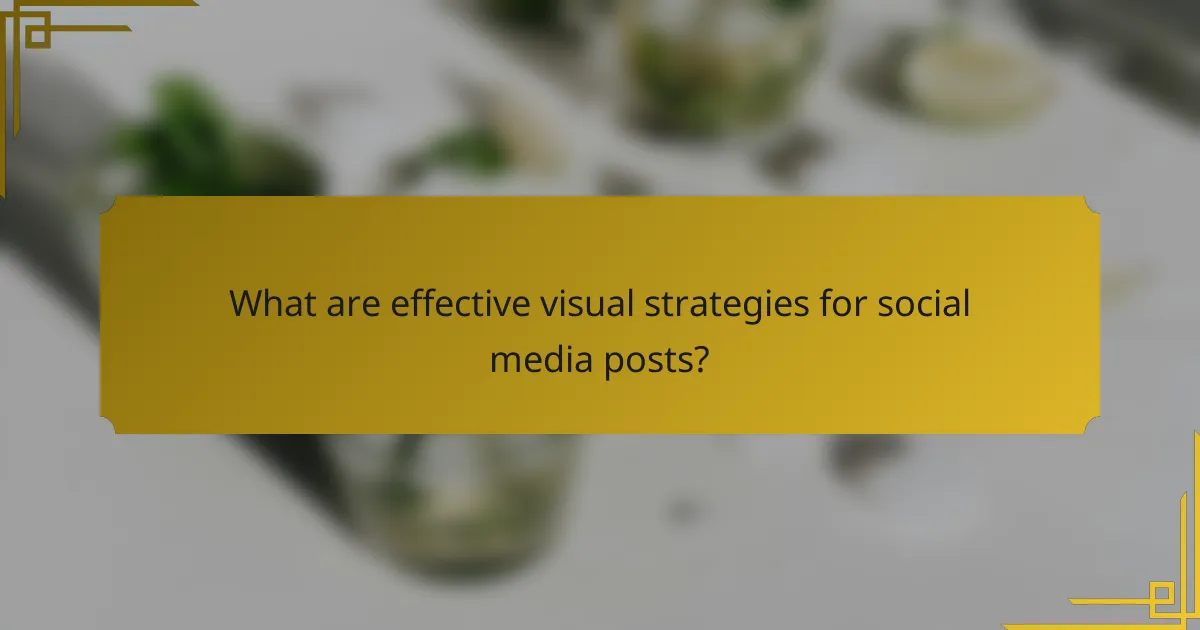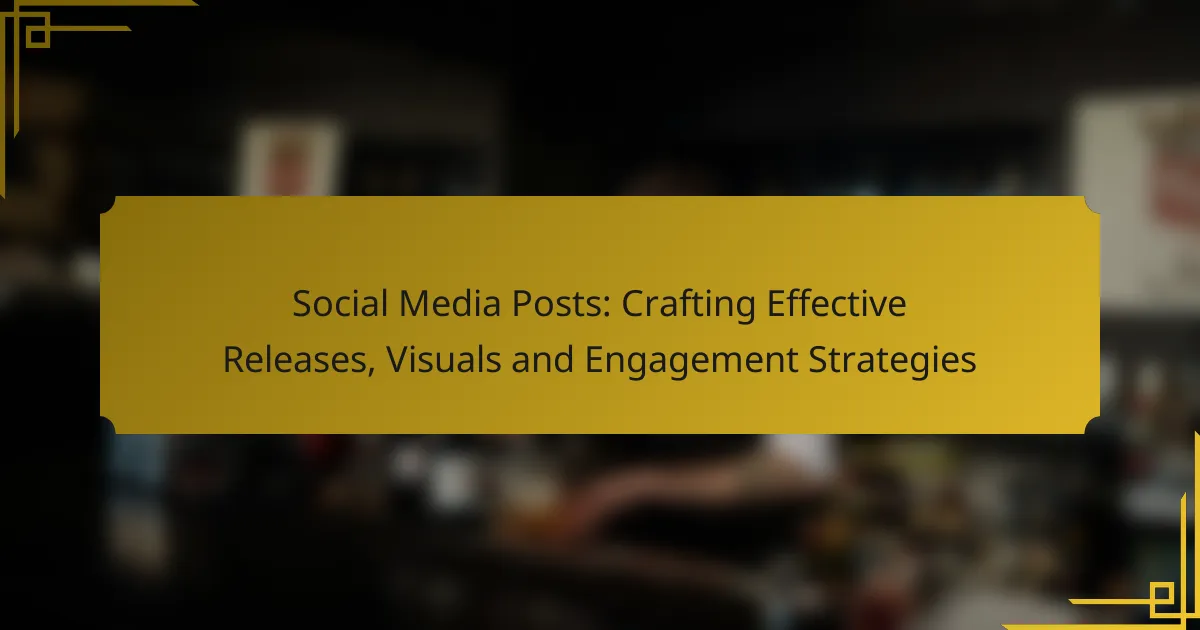Crafting effective social media posts requires a deep understanding of your audience and the implementation of strategic elements that capture attention. By leveraging storytelling, high-quality visuals, and interactive components, you can significantly enhance engagement and foster a connection with your followers. Additionally, measuring key metrics such as likes, shares, and comments will provide valuable insights into the effectiveness of your content and audience interest.

How to create engaging social media posts in the USA?
Creating engaging social media posts in the USA involves understanding your audience and using effective strategies to capture their attention. Focus on storytelling, user-generated content, trending hashtags, visuals, and interactive elements to enhance engagement.
Utilize storytelling techniques
Storytelling techniques can transform your social media posts by making them relatable and memorable. Share personal anecdotes, customer experiences, or brand journeys to create an emotional connection with your audience.
Consider using a narrative structure: introduce a challenge, describe the journey, and conclude with a resolution. This approach not only captivates but also encourages followers to engage with your content.
Incorporate user-generated content
User-generated content (UGC) is a powerful way to build community and trust. Encourage your followers to share their own experiences with your brand, and feature their posts on your profile.
This not only provides authentic content but also fosters a sense of belonging among your audience. Consider running contests or campaigns that incentivize users to create and share content related to your brand.
Leverage trending hashtags
Using trending hashtags can significantly increase the visibility of your posts. Research current popular hashtags relevant to your industry and incorporate them strategically in your content.
However, avoid overloading your posts with hashtags; a focused selection of 3-5 relevant tags is often more effective than a long list. Monitor hashtag performance to refine your strategy over time.
Use eye-catching visuals
Visuals are crucial for grabbing attention on social media. Use high-quality images, videos, or graphics that align with your brand identity and message.
Consider using tools like Canva or Adobe Spark to create visually appealing content. Infographics and short videos tend to perform well, as they convey information quickly and engagingly.
Engage with followers through polls
Polls are an excellent way to engage your audience and gather feedback. Use platforms like Instagram Stories or Twitter to create quick, interactive polls that invite followers to share their opinions.
This not only boosts engagement but also provides insights into your audience’s preferences, helping you tailor future content to their interests. Keep polls simple and relevant to encourage participation.

What are effective visual strategies for social media posts?
Effective visual strategies for social media posts focus on capturing attention and enhancing engagement. Utilizing high-quality images, infographics, video content, and consistent branding elements can significantly improve the impact of your posts.
Use high-quality images
High-quality images are essential for grabbing attention on social media. They should be clear, well-composed, and relevant to your content. Aim for images that are at least 1080 pixels wide for optimal display on most platforms.
Consider using stock photo services or hiring a photographer to ensure your visuals are professional. Avoid using blurry or poorly lit images, as they can detract from your message and brand perception.
Incorporate infographics
Infographics are effective for presenting complex information in a visually appealing way. They combine graphics and text to convey data or concepts quickly. Use infographics to summarize key points or statistics, making them easier for your audience to digest.
Keep your infographics simple and focused, using a limited color palette and clear fonts. Tools like Canva or Piktochart can help you create engaging infographics without needing advanced design skills.
Utilize video content
Video content is increasingly popular on social media and can lead to higher engagement rates. Short videos, typically under two minutes, are effective for delivering messages quickly. Use videos to showcase products, share testimonials, or provide tutorials.
Ensure your videos are optimized for each platform, including captions for silent viewing. Platforms like Instagram and TikTok favor vertical videos, while YouTube supports horizontal formats. Aim for high production quality to maintain professionalism.
Apply consistent branding elements
Consistent branding elements across your visuals help establish brand identity and recognition. Use the same color schemes, fonts, and logos in all your posts to create a cohesive look. This consistency builds trust and familiarity with your audience.
Develop a style guide that outlines your branding elements and visual standards. Regularly review your posts to ensure they align with your established branding, avoiding any mismatches that could confuse your audience.

How to measure engagement on social media?
Measuring engagement on social media involves tracking interactions that indicate how users are responding to your content. Key metrics include likes, shares, comments, and click-through rates, which collectively provide insight into audience interest and content effectiveness.
Track likes and shares
Likes and shares are fundamental indicators of engagement. A high number of likes suggests that your content resonates with your audience, while shares indicate that users find it valuable enough to distribute within their networks.
To effectively track these metrics, monitor your posts regularly and compare engagement levels across different types of content. For instance, visual posts often receive more likes and shares than text-only updates.
Analyze comment interactions
Comments provide qualitative insights into audience sentiment and engagement. Analyzing the tone and content of comments can help you understand what your audience appreciates or dislikes about your posts.
Encourage comments by asking questions or prompting discussions in your posts. Regularly review and respond to comments to foster a sense of community and enhance engagement.
Monitor click-through rates
Click-through rates (CTR) measure how often users click on links in your posts, indicating their interest in your content. A higher CTR suggests that your audience finds your calls to action compelling.
To improve CTR, ensure your links are relevant and your calls to action are clear and enticing. A good benchmark for social media CTR is typically around 1-3%, but this can vary by industry and platform.
Use analytics tools like Hootsuite
Analytics tools such as Hootsuite provide comprehensive insights into your social media performance. These platforms can track engagement metrics across multiple channels, allowing for easier analysis and reporting.
Utilize these tools to set benchmarks, monitor trends over time, and adjust your strategies based on data-driven insights. Regularly reviewing analytics can help you identify successful content types and optimize future posts for better engagement.

What are the best practices for scheduling posts?
Effective scheduling of social media posts involves strategic timing and the use of tools to maximize audience engagement. By following best practices, you can ensure your content reaches the right audience at the right time.
Utilize tools like Buffer
Using scheduling tools such as Buffer can streamline your posting process and enhance your social media strategy. These platforms allow you to plan and automate posts across multiple channels, saving time and ensuring consistency.
Buffer, for instance, offers analytics features that help you track engagement metrics, allowing you to refine your approach based on performance data. This can lead to improved reach and interaction with your audience.
Post during peak engagement times
Identifying and posting during peak engagement times is crucial for maximizing visibility. Generally, these times vary by platform and audience demographics, but many studies suggest that late mornings and early evenings on weekdays tend to see higher activity.
To determine the best times for your specific audience, consider using analytics tools to assess when your followers are most active. Adjust your posting schedule accordingly to align with these peak periods for optimal engagement.
Maintain a content calendar
A content calendar is an essential tool for organizing and planning your social media posts. It helps you visualize your content strategy over days, weeks, or months, ensuring a balanced mix of topics and formats.
When creating a content calendar, include key dates, themes, and post types to maintain variety and relevance. Regularly updating the calendar allows you to adapt to trends and audience feedback, keeping your content fresh and engaging.

What criteria should you consider for social media content?
When crafting social media content, consider factors like your target audience, the platform’s unique characteristics, and the type of engagement you want to foster. These criteria will help ensure your posts resonate with users and achieve your marketing goals.
Target audience demographics
Understanding your target audience demographics is crucial for effective social media content. Identify key characteristics such as age, gender, location, and interests to tailor your messaging appropriately. For instance, content aimed at younger audiences may leverage trends and humor, while posts for older demographics might focus on informative and straightforward messaging.
Utilize analytics tools to gather insights about your audience’s behavior and preferences. This data can guide your content strategy, helping you create posts that engage and convert your specific demographic effectively.
Platform-specific content types
Each social media platform has its own preferred content types that resonate with users. For example, Instagram thrives on visually appealing images and short videos, while Twitter is best for concise text updates and links. Tailoring your content to fit the platform’s strengths can significantly enhance engagement.
Consider the format and style that work best on each platform. For instance, Facebook allows for longer posts and community interaction, while TikTok focuses on creative, short-form video content. Adapting your approach to match these expectations will improve your chances of success across different channels.
